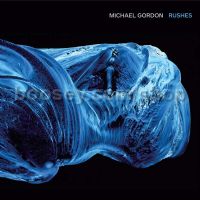Rushes (Cantaloupe Audio CD)
Rushes (Cantaloupe Audio CD)
Special Offer
* Estimated price converted from UK retail price
Composed for seven bassoons, Rushes takes its place alongside Michael Gordon’s Timber for expanding the boundaries of a single instrument’s repertoire into unknown (and at times, otherworldly) spaces. Like Timber, which maps new percussive territory for the simantra—a simple two-by-four slab of wood, amplified and played in a group of six to yield trance-like sonic textures—Rushes brings out tonal and timbral aspects of the bassoon that are meant to induce a quasi-meditative, almost ecstatic state, in the listener as well as the performer.
“The name comes from the tall grass that’s reminiscent of the reeds that bassoon players use,” Gordon told the Times-Union newspaper, just before the piece’s September 2012 premiere at Rensselaer Polytechnic Institute’s Experimental Media and Performing Arts Center (EMPAC) in Troy, New York. “It also refers to an ecstatic rush, a euphoria that I’m trying to build. It’s very visceral for the players, who are playing basically nonstop for an hour, and that requires a sense of intensity and concentration.”
The players themselves were open to the challenge. “One of my first impressions of the score was that it looked like a percussion piece!” remembers Dana Jessen, who organized the New Music Bassoon Fund that commissioned the work, and is one of the seven musicians on the official Rushes recording. “There weren’t any obvious melodic or lyrical lines that are common in wind music. Instead, we play continuous patterns and rhythms that lengthen and shorten, with subtle changes and shifts in dynamics from one player to the next.”
As technically demanding as Rushes can be in performance, the recording required an equal level of precision. Produced by Argeo Ascani at EMPAC, the result is rich, multi-layered and stunningly lush; there’s an analog and human “warmth” that resides in the natural sound of the bassoon, but Rushes also exposes how deceptively electronic a group of them can sound when played with arpeggiated gusto.
“The bassoon is very beautiful and sensual,” Gordon says. “After taking a good look at several centuries worth of bassoon music, I felt that the instrument had been overlooked. I see Rushes as a bassoon extravaganza—but at the same time, it’s propulsive, rhythmic and visceral.”
•Commissioned by the New Music Bassoon Fund and firstperformed in September 2012 at EMPAC in Troy, New York.
•Seven-piece Rushes Ensemble features the top bassoonistsin the U.S., including Huygens Fellowship recipient and Fulbright scholar Dana Jessen.




